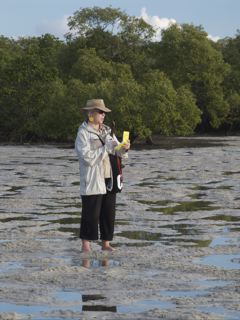
Some long time ago, while Raby Bay was still at the planning stage, I had a memorable conversation with the would-be developer. Uncle Arthur was a man I’d known since childhood. My siblings and I grew up together in the same street with his kids, and we are still mates.
Arthur dreamed up Raby Bay, discerning in the ‘worthless’ liminal territory between the land and water a bonanza development opportunity: new waterfront real estate. North-facing, too.
So Arthur was incredulous, even incensed, that an environmental impact statement would be required to assess the effects of removing the mangroves and dredging the bay. Nothing would persuade him mangroves had any value whatsoever.
I also remember a childhood summer holiday when we went fishing in the Mary River, Arthur-style, which entailed lobbing a stick or two of dynamite into the waterhole before wading in with plastic buckets to collect the stunned fish floating on top of the water. However, that is another story.
Mangroves are to be valued
As I reflect on it now, when Arthur and I had our conversation about the mangroves of Raby Bay, it was 30-odd years after Rachel Carson wrote about the liminal areas of 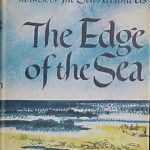 coastlines, teeming with life and significance. In The Edge of the Sea, published in 1955, she wrote:
coastlines, teeming with life and significance. In The Edge of the Sea, published in 1955, she wrote:
I doubt that anyone can travel the length of the Florida Keys without having communicated to his mind a sense of the uniqueness of this land of sky and water and scattered mangrove-covered islands.…This is a coast not formed of lifeless rock or sand, but created by the activities of living things.
Carson, a marine biologist, communicated to ordinary folk. She valued the shifting line between land and water as a place where we can sense ‘that intricate fabric of life by which one creature is linked with another and each with its surroundings’.
As everyone must know now, mangroves are neither worthless nor expendable. They perform crucial environmental services, including trapping sediments and helping purify the sea of toxins and other pollutants. They protect shorelines from erosion and buffer them against storms and tsunamis. They are nurseries and habitats for a myriad of sea life including fish, crustacea and shellfish. They store more carbon than rainforests do. Mangroves are magnificent and life-giving. They are also endangered.
It was Carson’s Silent Spring, published in 1962, challenging widespread use of pesticides like DDT, that sparked environmental awareness and put the whole world on notice to protect valuable and vulnerable ecosystems.
Uncle Arthur, untroubled by Carson’s message, held to a commonplace view that nature has to be battled, and razed wherever necessary, to enable development and progress. This is how Europeans have always approached settlement in Australia.
Combative language remains
Today, I hear the same combative language used in reference to Toondah Harbour. The mangroves are expendable. Tear them out. Tame the bay. Build a groyne half a kilometre long and stack it with multi-storey buildings. Dredge the mudflats. Put in a large marina. Never mind the prevailing south-easterlies. Never mind the acid-sulphate soils, either. Sink piles down to 80 metres. Build housing. Build high-rise. Build another Gold Coast. We deserve it.
A basic confusion bedevils and confounds the Toondah project. Does the goal to develop the land around the harbour stem from the need to make a workable port facility, or rather to create a high-rise development? It seems clear to me that these are fundamentally incompatible and irreconcilable objectives.
Industrial transport infrastructure does not sit easily alongside a commercial and residential destination. Co-locating these dissimilar functions would generate unacceptable traffic loads along the bottleneck of Middle Street, as well as massive demand for parking on the confined site.
Worse, development at Toondah Harbour must battle against nature – and must raze it. A potential developer could expect far more expensive and problematic construction than if building on a less conflicted site with, for example, good orientation and no flooding hazard.
The Toondah port needs to be fixed
Most people agree the outstanding priority at Toondah Harbour is a functional port. The existing facilities are inadequate. How many people know about the revenue-neutral strategy to rejuvenate the port? It is one of the key findings of the Toondah Harbour Urban Design Workshop convened by Shane Thompson, president of the Australian Institute of Architects Queensland Chapter in March. Ratepayers would naturally expect Redland City Council to carefully evaluate that particular proposition.
Most people also would agree that Cleveland would benefit from being put on the map, as the Mayor has signalled. At the Workshop, the 23 master planners had one question: why cram all the City’s economic and development eggs into a single small basket of land at Toondah Harbour, with its many environmental problems and functional conflicts, when promising but as yet overlooked opportunities exist at Raby Bay to develop an expansive recreational and tourism attraction?
Raby Bay is a grand recreational destination waiting to be fully appreciated. Here is a kilometre-long, north-facing waterfront parkland edged with small sandy beaches. Here, if people decide to do so, it would be viable to build finger wharves and create new real estate with water views – for residential, recreational, civic, commercial purposes. Development here won’t entail traffic bottlenecks or the destruction of marine ecosystems and koala habitat. The precinct is an easy walk from the railway station and from Cleveland’s existing commercial centre, in dire need of urban consolidation rather than dispersal to Toondah Harbour.
Raby Bay no longer has its cloak of mangroves. Paradoxically, perhaps, in this artificially created location, developers can work with nature, not against it, reaping the benefits of perfect orientation and straightforward construction.
Uncle Arthur would be among the first to see serious development potential in that.
Post by Jackie Cooper – 20 July 2014
Please note: Offensive or off-topic comments will be deleted. If offended by any published comment please email thereporter@redlands2030.net
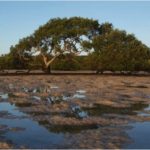
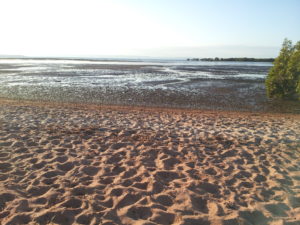

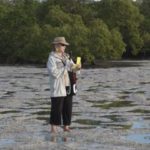
8 Comments
Jo Kaspari talks about the value of the mangroves after discussions with marine biologists and bio-chemists. I am one of those marine biologists and my whole PhD study was spent on marine life within Moreton Bay. It included the discovery of 14 new marine species. Jo is right. The mangrove systems of Moreton Bay are like the child-care systems for humans. They look after the juvenile stages of fish, crustaceans and even commercially valuable species like king prawns. They also provide the food for our migrating shore-birds. Do we really want to destroy these ecosystems and replace them with concrete slabs so that wealthy developers can become more wealthy?
Good article on the benefit of mangroves. It would also mean not surrendering a very well used, very old public parkland and would assist in meeting the RAMSAR agreement. Cleveland is the obvious hub with the public transport facilities of rail and bus with Toondah relying only on cars. If a body with the professional knowledge of the Australian Institute of Architects say that Toondah is not the best choice for this type of development why do our councillors think they have the knowledge to say otherwise?
My time spent in the company of the marine biologists and bio-chemists whom build their vocations around the marine life of Moreton Bay, will tell you of the ecological necessity of mangroves. If we so value the bay, we must look to it as a whole not just its isolated deep waters that host whales and are a thoroughfare for boats to the island.
Thank you, Jackie, for your well thought out and compelling argument. Cleveland doesn’t need another weak branch. It needs to strengthen the ones it has and it absolutely cannot afford to lose any more mangroves.
http://www.abc.net.au/news/2014-07-21/coal-terminals-dredging-put-great-barrier-reef-at-risk-inquiry/5612572
Fast tracking, Cutting Red-Tape. Sounds familiar.
Development in Cleveland doesn’t need to be on the water front at all Toondah. The Raby Bay development at least added to the parkland of Cleveland plus, amazingly, the beaches have survived well. Toowong Village Shopping Centre is a good example of what could be done in central Cleveland in the existing retail centre.
Beautifully written with clear rationale for what is needed at Toondah Harbour. The Gateway to Straddie where one can wind down – not the residential precinct for 3000 commuters to the city, with all its infrastructure costs that will be born by Redlands Ratepayers.
The article very well describes the situation and the need to rethink the Toondah Harbour plans.